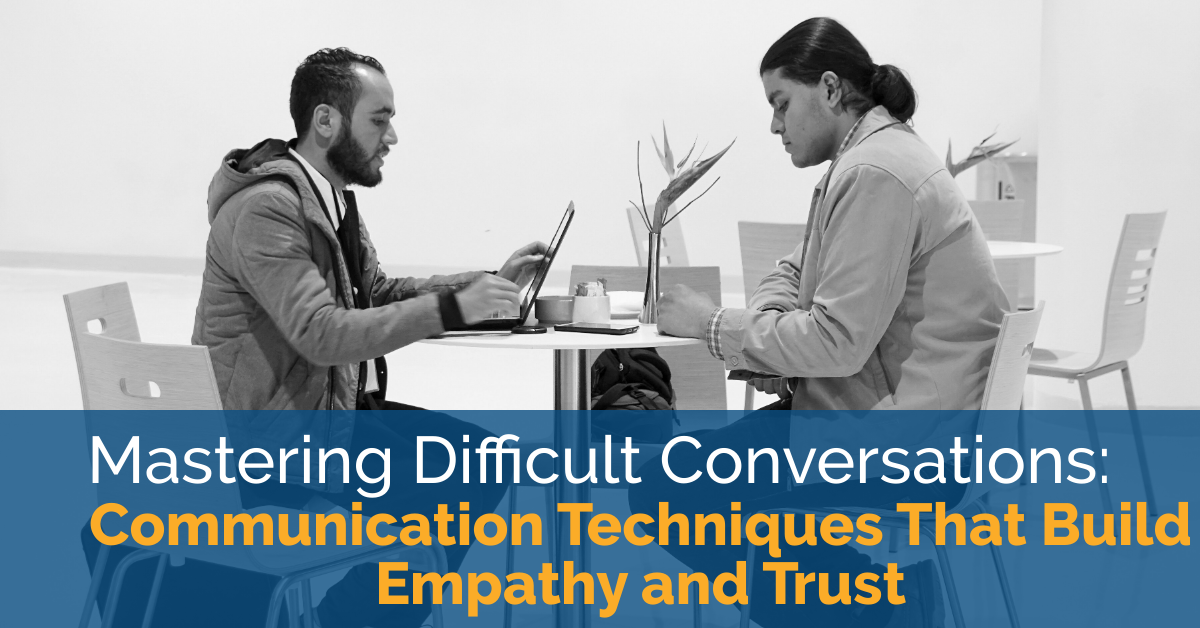
Mastering Difficult Conversations: Communication Techniques That Build Empathy and Trust
Understanding the Psychology of Avoidance
Avoiding difficult conversations is a common human response. We fear emotional reactions—anger, sadness, defensiveness—or worry about damaging relationships. However, avoidance often leads to greater tension, misunderstandings, and fractured trust. The longer we delay, the more complex the situation becomes.
The honeymoon is over.
If you’ve been there too, here’s what my clients found helped them shut off that voice, that nagging imposter monkey, sitting on your shoulder.
Why Empathy Matters
Empathy is the cornerstone of meaningful communication. It’s not about saying “I understand,” but about showing genuine effort to imagine what someone might be going through. In emotionally charged moments, empathy helps others feel seen, heard, and valued.
One example from the podcast illustrates this beautifully: an airline staff member faced a frustrated passenger after a 26-hour flight delay. Instead of hiding behind a counter, she made eye contact, acknowledged the passenger’s exhaustion, and physically stepped out to walk her to the gate. That simple act of presence and empathy transformed a negative experience into a moment of genuine care.
This brief animated short shares Brene Brown’s succinct explanation of empathy and how it differs from sympathy: https://www.youtube.com/watch?v=1Evwgu369Jw
The Human Side of Work
Behind every role or task is a human being with emotions and vulnerabilities. Recognising this is essential for effective communication. Leaders who acknowledge and embrace the human side of work foster environments where team members feel safe, respected, and supported—even during tough conversations. People tend to set aside their feelings at work in the name of professionalism. However, the human side of work involves embracing authenticity, being genuine, and respecting the full spectrum of emotions.
Communication Techniques for Difficult Conversations
Effective communication in challenging moments requires preparation, clarity, and emotional intelligence. Here are helpful steps in delivering a difficult message:
1. Know your audience
Tailor your message to the people receiving it. Avoid one-size-fits-all approaches and consider the emotional and cultural context.
2. Prepare and rehearse
Understand the rationale behind the message and practice how you’ll deliver it. This helps reduce anxiety and ensures clarity.
3. Stick to key points
Avoid overexplaining or drifting into unrelated details. Keep the message focused and concise.
4. Explain the context
Help the receiver understand the “why” behind the decision. This builds transparency and trust.
5. Validate emotions
Acknowledge what the person is feeling without trying to fix it immediately. Phrases like “I can see this is upsetting” or “I imagine this is frustrating” show empathy without overstepping.
6. Hold space
Be present and attentive. Use open body language, eye contact, and silence to allow the person to process their emotions.
Dos and Don’ts of Delivering Tough News
Do:
- Prepare thoroughly
- Be empathetic and present
- Provide context and clarity
- Allow space for emotional reactions
Don’t:
- Sugarcoat or give false hope
- Collude with the receiver’s emotions
- Let personal feelings cloud the message
- Add unrelated or excessive information
Feedback That Fosters Growth
Constructive feedback is essential for development. Research shows that people appreciate honest feedback when it’s framed with belief in their potential. In Daniel Coyle’s book “The Culture Code”, he highlights a phrase used by middle school teachers that improved effort and performance significantly and which researchers called “magical feedback”. The simple yet powerful phrase is:
I’m giving you these comments because I have high expectations and I know you can reach them.
This kind of framing communicates belonging, safety, trust, support, and a shared commitment to growth.
In the workplace, the phrasing may sound like:
I am sharing these comments as we set high expectations that you’re capable of. I want to help you achieve those standards.
I wish to share this feedback as my goal is to support your growth. I see great potential in you and let’s work together to reach these goals.
I’m sharing these comments because I am aware of your high standards and I’m here to help you succeed.
Building a Culture of Feedback
Organisations that prioritise feedback and emotional intelligence create cultures of trust and continuous improvement. Whether through digital tools, regular check-ins, or leadership training, embedding strong feedback techniques into daily practice leads to healthier, more resilient teams.
Difficult conversations don’t have to be damaging. With empathy, emotional intelligence, and thoughtful preparation, they can become opportunities for clarity, connection, and transformation. Whether you’re a leader, coach, or team member, your ability to navigate tough talks with care and confidence will define the strength of your relationships—and the culture you help create.
Want to learn more about this. Listen and subscribe to the podcast here: Feel It, Own It, Skill It – The Human Side of Work
If you want to improve your behavioural skills and master the human side of work, book your free strategy session here: Book here
Check out our upcoming free MASTERCLASSES that focus on how to Feel Good at Work, how to work Better Together, Talk Smart (communication techniques), Mission Control (leadership techniques), Essential Human Skills, and how to Tame Your Time.
If you want to improve your behavioural skills and master the human side of work, book your free strategy session here.
Listen to Podcast Here:
About the Author



